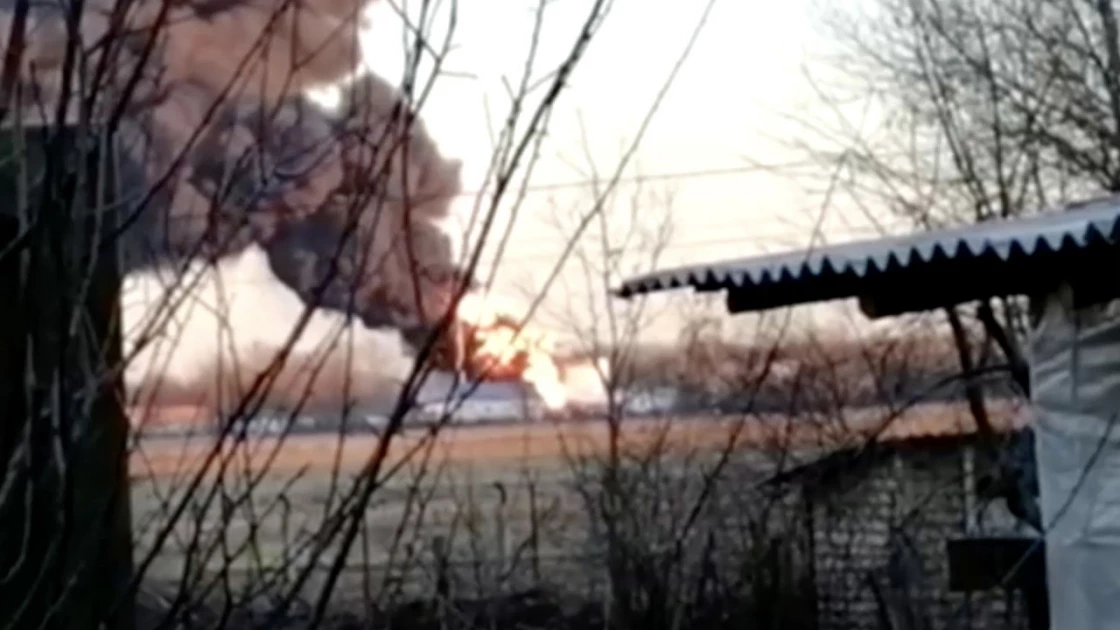Blasts deep inside Russia hand Putin a fresh problem, with no obvious answer

Footage on Russian media shows the aftermath of an alleged drone strike Tuesday at an airfield in Kursk, Russia. PHOTO/COURTESY: CNN
Moscow’s accusation that Ukrainian drones struck two
airbases deep inside Russia has once again raised the febrile question of
escalation nine months into the war.
The strikes are an extraordinary breach of Russia’s
assumptions that it can protect its deep interior, from which safe harbors its
strategic bombers have caused carnage across Ukraine with relative impunity.
These are airbases very far inside Russia, and whatever the truth of the
strikes – whether they represent a new long-distance drone
capability Ukraine has advertised, or there’s another explanation – this
is just not something that was meant to happen when Russian President Vladimir
Putin launched his “10-day invasion” in February.
Week by week, there are yet more signs that Moscow’s military machine
cannot do what it says on its can.
On Tuesday, a Russian official said another drone strike had hit a
Russian airfield in Kursk, nearer to the Ukrainian border.
Ukraine has neither confirmed nor denied responsibility for the blasts,
in keeping with Kyiv’s policy of official silence around attacks inside Russia
or in Russian-occupied Crimea.
An aide to President Volodymyr Zelensky appeared to gloat over the
strikes, tweeting cryptically that “if something is launched into other
countries’ airspace, sooner or later unknown flying objects will return to
departure point.”
Russian state
news agencies heaped discomfort onto humiliation by adding Monday that the initial two
airfields in question had in fact been photographed by a US-based commercial
satellite imaging company over the weekend.
The low-tech
tools employed in this embarrassment pop the balloon of Russia’s peer status to
NATO
Russian humiliation is usually accompanied with concerns it may escalate
the conflict.
But it is hard to know what else Russia could do to Ukraine that it has
not already done.
It has leveled cities, hit civilian infrastructure callously and
relentlessly when it can, killed thousands of civilians and yet more troops,
and bombed maternity hospitals and shelters marked with the word
“Children.”
At some point, the labored assumption that Russia has magic,
non-apocalyptic buttons left to press will begin to fade.
Let us first quickly discuss why a Russian nuclear strike seems off the
table, at least for now.
After months of deeply chilling nuclear rhetoric – spanning potential
“accidents” at nuclear power stations, to evidence-free talk of Ukraine using a
dirty bomb, to open threats invoking Moscow’s nuclear arsenal – Moscow seems to
have eased off on the Armageddon rhetoric.
At the end of last month, Putin found himself in an extraordinary
moment, signing a decree with the president of Kazakhstan reiterating that
nuclear war can never be won and should never be fought.
It was a reinforcement of a 2006 statement between Moscow and the
Central Asian states it back then sought to lead as a geopolitical power.
How times have changed: Moscow is no longer looking outwards to the West
as it began to 16 years ago.
And Kazakhstan, who as recently as January depended on Moscow to put
down internal unrest, is looking to China and Europe for its future, and
seemingly nudging Putin to pledge again that nukes are bad.
None of this excludes the remote possibility the Kremlin will give in to
the lunatic fringe on state TV talk shows and unleash its worst weapons.
But it is clear that everyone Putin knows is now reminding him of the
stark consequences were he to do so.
So what does Russia have left? Chemical weapons are a possibility, but
likely have formed a part of the warnings it has received to not use nuclear
force.
Moscow’s choices appear limited to the more accurate or savage use of
the same conventional brutality it is currently throwing at Ukraine’s cities
almost daily.
This is the most damaging side effect of how public the exhaustion of Russia’s
military has been: There is no real “fear factor” left.
State TV commentators liked to muse months ago that Russia has thus far
been fighting with “gloves on,” but it is clear the gloves have long come off,
their opponent has learned to duck their punches, and also brought a knife to
the ring.
This open
degradation of Russia as a power was compounded by claims – hard to confirm –
from Ukrainian officials that over four in five Russian missiles fired Monday
were intercepted by Kyiv’s boosted air defense systems.
Again, this
is another of the certainties held about the Russian military shattered. Its
air attack and defense systems are being outperformed in the same week.
The better Ukraine’s military performs on the battlefield, the less
likely Kyiv are to agree with some European capitals that peace talks are
needed with Russia.
When you are winning, why agree to talk about a form of losing? And NATO
cannot begin to slow the supply of weapons or face criticism – even from its
own citizens – that it is leaving Ukrainians to die.
It cannot really demand Kyiv accept the permanent loss of some of its
territory as part of a settlement without essentially endorsing Russia’s
invasion.
Instead, the dynamic is all against Russia. When they are weak, they are
not suddenly somehow strong – they are just weak, to paraphrase one Western
official’s private analysis.
Do these slow and continual humiliations bring the day closer when Putin
struggles to control his own hierarchy, or succumb to pressure to withdraw from
territory he has occupied since 2014?
As we wait for the answer, the trajectories are unchanged: Ukraine: cold
in winter, but winning and slowly better armed. Russia: cold in winter, but
losing and slowly broken militarily.
Want to send us a story? SMS to 25170 or WhatsApp 0743570000 or Submit on Citizen Digital or email wananchi@royalmedia.co.ke
Comments
No comments yet.


Leave a Comment